
Island House Resort / Singer's Resort
History
By: Arnold Alanen and Kathryn Franks
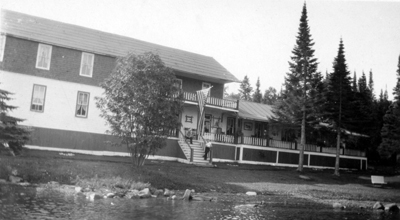
Singer's Resort, ca. 1930: Don Anderson Collection, ISRO Archives.
Oral History 01, Clip 2: Edgar Johns, September 1965, Lawrence Rakestraw: ISRO Archives.
alter H. Singer, head of the Lake Michigan & Lake Superior transportation company, answered the need for a full-service public resort on Isle Royale in 1902. There was strong competition in the booming Great Lakes shipping industry at the turn of the century, and the biggest plans and the most money often secured domination of the most profitable shipping routes. Isle Royale was part of Singer's plan to compete with the strong financial clout of A. Booth and Company, a shipping and fishing firm that had been working to control the industry on the North Shore. Singer planned to capitalize on the expanding tourist industry on Isle Royale, which would permit him to compete with Booth and Company.
Singer began his resort development by building an exceptionally large dock at Washington Harbor to accommodate the Iroquois, his new, two-hundred-passenger ship. The Booth Company responded by placing one of their fastest ships, the America, in direct competition for the Isle Royale and North Shore trade. After establishing the Iroquois on the Isle Royale route, Singer began promoting his plans for an Isle Royale resort. He set the location on Washington Island, at the far west end of Isle Royale. It was here he built the Island House, a two-story frame hotel, complete with a kitchen, and dining room, and private guest rooms. Ten cottages were built along the lakeshore on both sides of the main building. A boardwalk was built along the shore, and a recreation building which included a bowling alley (that doubled as a dance floor) was constructed. An immense radio tower was erected in 1910 to be used for both entertainment and navigation. Singer's was the first full-service resort on Isle Royale, and brought a dramatic change in the island resort accommodations. The Island House "became the principal destination for Isle Royale-bound travelers between 1904 and 1920. In time, the Washington Island resort became known as "Singerville."
"My father and mother got too old and couldn't do it any longer. My father talked to Walter Singer and he said, "Why don't you take over now and put a hotel in Washington Harbor?" Well, Singer thought it over and thought it would be a good idea". --Edgar Johns, 1965.Singer's resort was representative of the "golden era" in Isle Royale's tourism history. During this period, the island was alive with tourists (the Island House was on the regular schedule of five different passenger boats), more consistent communication was available on the island, passenger ships like the America and the Iroquois provided comfortable accommodations for tourists, and rail-boat trips were offered to Isle Royale from Chicago, St. Paul. Minneapolis, and by the Omaha Railroad. Steamers stopped so frequently that in 1904 a customhouse was established on Washington Island. The island had seen so much growth as a result of Singer's resort, that in 1904 the Duluth Herald wrote:
"The day is near at hand when Isle Royale will be the objective point for people from all over the country. Persons of wealth, or, at least, moderate means, will compose the throng...Isle Royale will become the Mackinac of Lake Superior."However, regardless of the success of his resort, profits were not what Singer had hoped, and due to several unexpected problems related to his fleet (one vessel caught fire and burned, and several consecutive docking accidents occurred with the Iroquois), the Iroquois was eventually eliminated from Isle Royale trade route, and the America of Booth and Company became the new main access to the island for tourists. Run by his wife Mary, Singer's hotel remained the one the leading resort destinations on Isle Royale until the Belle Isle Resort upgraded in the early 1920s.[2]
Image Gallery
Citations
- Franks, Kathryn E. and Arnold R. Alanen, 1999. Historic Structures at Isle Royale National Park: Historic Contexts and Associated Property Types. Department of Landscape Architecture, University of Wisconsin-Madison, January 1999.
- Scarpino, Philip. 2010. Cultural Resources on Isle Royale National Park: An Historic Context. Unpublished Manuscript. Pp. 108. Print.

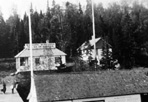
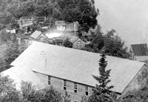
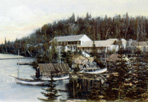
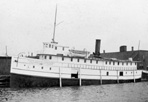
![Singer's Resort, Main Lodge, 1935: Wolbrink Collection [Sheet 18, Photo B], ISRO Archives.](../Island_House_Resort/Jpegs/Small/Wolbrink_Photos_Sheet_018b.jpg)
![Singer's Resort, Main Lodge (rear), 1935: Wolbrink Collection [Sheet 18, Photo C], ISRO Archives.](../Island_House_Resort/Jpegs/Small/Wolbrink_Photos_Sheet_018c.jpg)
![Singer's Resort, Main Lodge (rear), 1935: Wolbrink Collection [Sheet 18, Photo D], ISRO Archives.](../Island_House_Resort/Jpegs/Small/Wolbrink_Photos_Sheet_018d.jpg)
![Singer's Resort, Cottage C, 1935: Wolbrink Collection [Sheet 19, Photo A], ISRO Archives.](../Island_House_Resort/Jpegs/Small/Wolbrink_Photos_Sheet_019a.jpg)
![Singer's Resort, Cottage A, 1935: Wolbrink Collection [Sheet 19, Photo B], ISRO Archives.](../Island_House_Resort/Jpegs/Small/Wolbrink_Photos_Sheet_019b.jpg)
![Singer's Resort, South Cottage, 1935: Wolbrink Collection [Sheet 19, Photo C], ISRO Archives.](../Island_House_Resort/Jpegs/Small/Wolbrink_Photos_Sheet_019c.jpg)
![Singer's Resort, Singer's Cottage, 1935: Wolbrink Collection [Sheet 19, Photo D], ISRO Archives.](../Island_House_Resort/Jpegs/Small/Wolbrink_Photos_Sheet_019d.jpg)
![Singer's Resort, Cottage F, 1935: Wolbrink Collection [Sheet 20, Photo A], ISRO Archives.](../Island_House_Resort/Jpegs/Small/Wolbrink_Photos_Sheet_020a.jpg)
![Singer's Resort, Cottage B, 1935: Wolbrink Collection [Sheet 20, Photo B], ISRO Archives.](../Island_House_Resort/Jpegs/Small/Wolbrink_Photos_Sheet_020b.jpg)
![Singer's Resort, Main Dock Warehouse, 1935: Wolbrink Collection [Sheet 20, Photo C], ISRO Archives.](../Island_House_Resort/Jpegs/Small/Wolbrink_Photos_Sheet_020c.jpg)
![Singer's Resort, Dance Hall, 1935: Wolbrink Collection [Sheet 20, Photo D], ISRO Archives.](../Island_House_Resort/Jpegs/Small/Wolbrink_Photos_Sheet_020d.jpg)
![Singer's Resort, Help Cottage, 1935: Wolbrink Collection [Sheet 21, Photo A], ISRO Archives.](../Island_House_Resort/Jpegs/Small/Wolbrink_Photos_Sheet_021a.jpg)
![Singer's Resort, Cottage H, 1935: Wolbrink Collection [Sheet 21, Photo B], ISRO Archives.](../Island_House_Resort/Jpegs/Small/Wolbrink_Photos_Sheet_021b.jpg)
![Singer's Resort, Barn, 1935: Wolbrink Collection [Sheet 21, Photo C], ISRO Archives.](../Island_House_Resort/Jpegs/Small/Wolbrink_Photos_Sheet_021c.jpg)
![Singer's Resort, Sam Sivertson Cottages, 1935: Wolbrink Collection [Sheet 21, Photo D], ISRO Archives.](../Island_House_Resort/Jpegs/Small/Wolbrink_Photos_Sheet_021d.jpg)
![Singer's Resort, Cottage I, 1935: Wolbrink Collection [Sheet 22], ISRO Archives.](../Island_House_Resort/Jpegs/Small/Wolbrink_Photos_Sheet_022.jpg)
![Singer's Resort, 1938: W. Hill [NVIC: 30-149], ISRO Archives.](../Island_House_Resort/Jpegs/Small/Singers-NVIC-30-149.jpg)
![Singer's Resort, 1938: W. Hill, [NVIC: 50-1129], ISRO Archives.](../Island_House_Resort/Jpegs/Small/Singers-NVIC-30-150.jpg)
![Singer's Dock, 1950: Kurtz, [NVIC: 50-060], ISRO Archives.](../Island_House_Resort/Jpegs/Small/Singers-NVIC-50-060.jpg)
![Singer's Warehouse and Dock, 1953: Hakala, [NVIC: 50-462], ISRO Archives.](../Island_House_Resort/Jpegs/Small/Singers-NVIC-50-462.jpg)
![Singer's Warehouse and Dock, 1953: Hakala, [NVIC: 50-463], ISRO Archives.](../Island_House_Resort/Jpegs/Small/Singers-NVIC-50-463.jpg)
![Singer's Warehouse and Dock, 1953: Hakala, [NVIC: 50-464], ISRO Archives.](../Island_House_Resort/Jpegs/Small/Singers-NVIC-50-464.jpg)
![Singer's Warehouse and Dock, 1953: Hakala, [NVIC: 50-465], ISRO Archives.](../Island_House_Resort/Jpegs/Small/Singers-NVIC-50-465.jpg)
![Singer's Warehouse and Dock, 1953: Hakala, [NVIC: 50-466], ISRO Archives.](../Island_House_Resort/Jpegs/Small/Singers-NVIC-50-466.jpg)
![Singer's Warehouse and Dock, ca. 1955: ISRO Archives. [NVIC: 50-1158].](../Island_House_Resort/Jpegs/Small/Singers-NVIC-50-1158.jpg)
![Singer's Warehouse, ca. 1955: ISRO Archives. [NVIC: 50-1159].](../Island_House_Resort/Jpegs/Small/Singers-NVIC-50-1159.jpg)
![Singer's Warehouse, ca. 1955: ISRO Archives. [NVIC: 50-1160].](../Island_House_Resort/Jpegs/Small/Singers-NVIC-50-1160.jpg)
![Singer's Warehouse, ca. 1955: ISRO Archives. [NVIC: 50-1161].](../Island_House_Resort/Jpegs/Small/Singers-NVIC-50-1161.jpg)